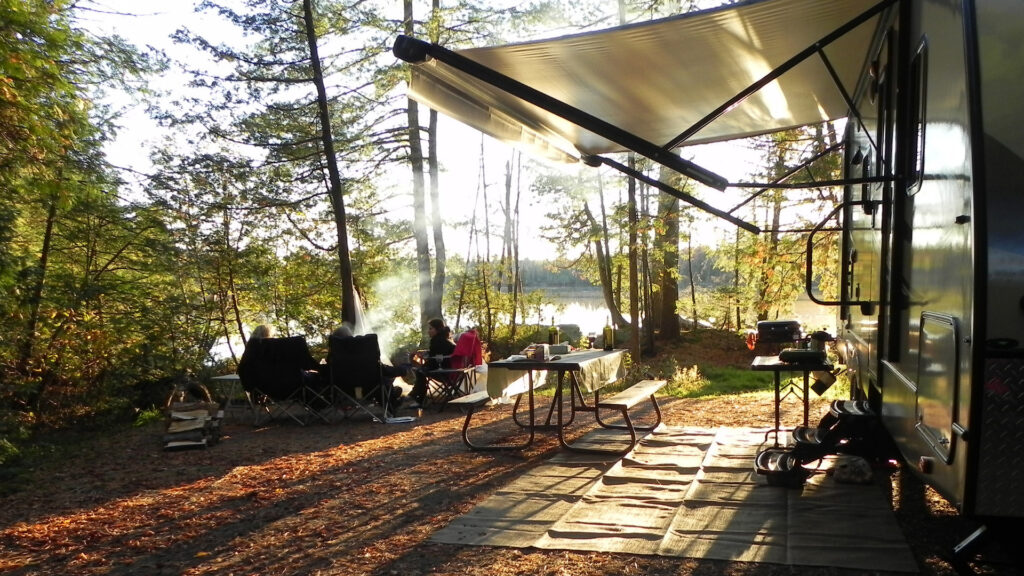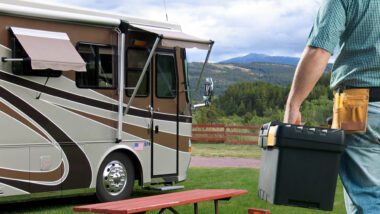Table of Contents Show
Many RVers love to boondock but stay limits restrict how long you can stay in one spot or area. However, some long-term boondocking sites allow you to stay for weeks or even months at a time. These types of campsites are a great way to RV, especially if you RV in the winter months. Let’s take a look at long-term boondocking sites and how you can use them legally. Let’s get started!
What Is Long-Term Boondocking?
Long-term boondocking means dispersed camping at a location for an extended period. While many boondocking spots have stay limits ranging from five to 14 days, long-term areas allow RVers to stay up to seven months.
You can use Long-Term Visitor Areas managed by the Bureau of Land Management. These locations require a permit that can range from $40 to $180, depending on the length of stay. All of the Long-Term Visitor Areas sit in the southern deserts of California and Arizona. RVers flock here for the freedom they provide and not necessarily the beautiful landscapes.
These campsites have a first-come-first-serve basis. If you hope to snag one of these sites, plan to arrive before Thanksgiving, as many of the best sites fill up as snowbird RVers migrate from the north to the south seeking warmer temperatures.
Make sure you do your research and come prepared for the environment. A couple of the Long-Term Visitor Areas offer access to water, a dump station, and even showers, but most do not. You’ll want to have a plan for power and managing your fresh and wastewater tanks.
What Do You Need for Long-Term Boondocking?
For the best long-term boondocking experience, you’ll want to make sure you have a few things before setting up camp. Let’s take a look and see what you might want to add to your supply list before your trip.
Solar Power
When it comes to long-term boondocking, solar energy is one of the best ways to power your RV. Many long-term sites and all Long-Term Visitor Areas are in the middle of the desert, which can provide a tremendous amount of sun for solar panels.
Once you have your solar system up and running, you have very little maintenance required. You won’t have to worry about oil changes or fuel for a generator, and you’ll also get to enjoy the quietness these remote locations provide. You don’t want a loud generator humming in the background as you try to enjoy a beautiful sunset or a night of stargazing.

Fresh Water Storage
You can access freshwater better at some long-term boondocking sites than others. This means you’ll need to have a plan for how you’ll store water to ensure you don’t find yourself in the middle of the desert with no water access. You’ll need water for drinking, bathing, and doing dishes, so freshwater storage is a must.
Many RVers will use portable jugs or water bladders to store water to and from a water source. Make sure to familiarize yourself with the process for filling up your freshwater tank and have all the necessary pieces of equipment to do so. You may need to invest in a portable water pump or other accessories to make filling your freshwater tanks as easy as possible.
Water-Saving Techniques
You’ll have more difficulty accessing water while boondocking than when you camp in an established campground. You’ll want to make sure you and everyone in your RV conserve as much water as possible to make it last.
This may mean using paper or plastic products to reduce the number of dishes, delaying or taking short showers, and even purchasing gallons of drinking water to extend the life of the water in your freshwater tank.
Your water-saving techniques and skills will grow the more you boondock. You’ll likely find you can get by with far less water than you might think once you get the hang of things.

Learn How to Find Dump Stations
Whether it’s your grey or black water tanks, you’ll need a plan for disposing of your wastewater. It is often illegal to dump any grey or black water on the ground, and you should always dispose of your wastewater in a sanitary method. It may require some effort to locate dump stations near you.
Many RVers use popular apps like Campendium and iOverlander to find dump stations. You may get lucky and find a dump station at a rest stop or gas station, but you can also call local campgrounds and see if they will allow you to use a dump station. Fees for using a dump station will vary from one location to the next, but they typically range from $5 to $20.
Some of these dump locations will also provide access to fresh water. This means you can dump your wastewater and fill up your fresh tanks. A quick trip through one of these dump stations, and you’ll be ready for your next long-term boondocking adventure.
Is Long-Term Boondocking Legal?
Yes, long-term boondocking is legal, as long as you follow all of the guidelines. In addition to securing a permit, you must follow all of the posted stay limits and all long-term boondocking regulations. Regulations will vary from one location to the next and so you’ll want to familiarize yourself with any unique rules in the area.
It is important to note that you cannot simply set up camp anywhere and declare that you’re long-term boondocking. You have to use designated spaces and areas, and local authorities have every right to fine or ticket you if you don’t follow protocol.
How to Do Long-Term Boondocking Safely and Legally
There are a few things you’ll want to keep in mind to stay safe and legal while long-term boondocking. Let’s take a look so you stay on the right side of the law.
Obey Posted Stay Limits
Stay limits are not suggestions. The authorities are perfectly within their right to issue a citation or fine for staying longer than the allowed time.
Just because you didn’t see the ranger doesn’t mean they haven’t taken note that you’re staying at a particular site. You may think that you’re getting away with something, but rangers monitor some areas very closely.
Obeying the posted stay limits isn’t something that we should do to avoid a fine or citation. By following the stay limits, you allow others to use the space and give time for the land to heal. This ensures that grounds are available for use for years to come.
Move to Different Management Areas When Necessary
On top of stay limits, some regulations will require you to move to another management area after so many days. You are responsible for making sure you follow the rules and move the required distances or outside the correct management area boundaries.
Scope Out Your Next Spot Before You Bring Your RV
You can safely scope out your next campsite without a tow vehicle or RV. If you find yourself in a sticky situation, you can turn around much easier than if you tow a massive RV. Getting yourself too far down the road where you can’t turn around can be dangerous and stressful. Taking your RV to an unfamiliar boondocking site could potentially damage your RV or tow vehicle. Your free camping spot could lead to a costly repair.

How to Find Long-Term Boondocking Spots
You can join Facebook groups where RVers share some of their best long-term boondocking spots. However, the best sites are often only shared amongst close circles. Make buddies with some experienced boondockers, and you may just find out about some of the best boondocking spots you’ve seen shared online.
The Bureau of Land Management also provides a very useful map to help you find possible sites. You can also use resources like Campendium and iOverlander to help you select which sites you think might work best for your stay.
Give It a Try
Long-term boondocking can help you get to know a new area. It allows you to stay for an extended time and learn the lay of the land without having to pack up and move every couple of weeks. We highly recommend giving it a shot if you find yourself in Arizona or Southern California during the winter months. Would you consider long-term boondocking?






